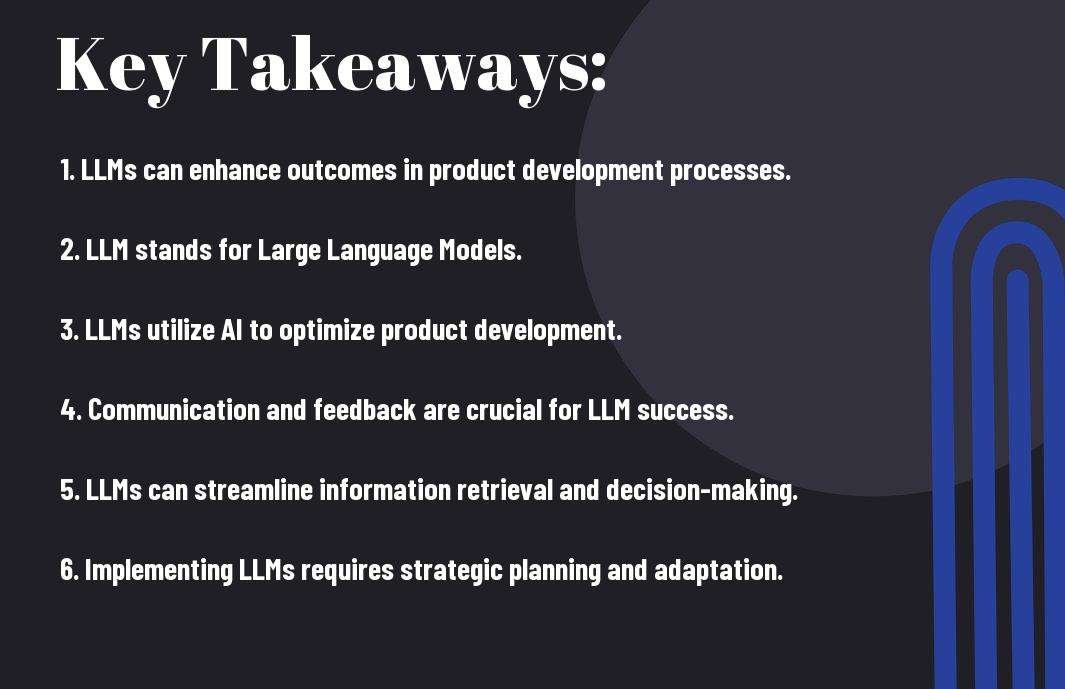It’s no secret that embracing Large Language Models (LLMs) can be a game-changer in optimizing your product development processes. In this exploration inspired by Malcolm Gladwell’s approach, we shed light on how LLMs can revolutionize your product development strategies. Dive deeper into the world of LLMs and their impact on product development by reading our article Connecting the Dots: Unravelling OpenAI’s Alleged Q-Star ….
Key Takeaways:
- LLMs can enhance product development: Leveraging Large Language Models (LLMs) in product development processes can lead to improved efficiency, accuracy, and creativity in ideation, design, and testing.
- Collaboration with LLMs can drive innovation: By working with LLMs, teams can access vast amounts of data and insights, enabling them to explore new avenues, refine existing products, and introduce innovative features.
- Continuous learning and adaptation are imperative: To fully optimize product development processes with LLMs, teams must be committed to ongoing learning, adapting strategies, and understanding the capabilities and limitations of these advanced models.
The Rise of Large Language Models
The Advent of AI in Product Development
For decades, product development processes have relied on human expertise and traditional methods to innovate and create new products. However, with the advent of Artificial Intelligence (AI), there has been a significant shift in how products are developed. AI has enabled businesses to analyze vast amounts of data, identify trends, and make predictions to optimize their product development strategies. By incorporating AI into your product development process, you can streamline decision-making, accelerate development timelines, and enhance product quality.
The Emergence of LLMs as a Game-Changer
Adventuring into AI, one cannot ignore the emergence of Large Language Models (LLMs) as a game-changer in optimizing product development processes. LLMs, like OpenAI’s GPT-3, are capable of processing and generating human-like text, making them invaluable tools for tasks such as natural language processing, text generation, and even code generation. Leveraging the power of LLMs in your product development endeavors can lead to improved communication, faster iteration cycles, and more efficient problem-solving.
Large Language Models have the potential to revolutionize your product development process by providing you with unprecedented levels of insight and assistance. With their ability to understand context, generate text, and assist in decision-making, LLMs can empower you to innovate faster and more effectively. By incorporating LLMs into your workflow, you can tap into a vast repository of knowledge and expertise to drive your product development initiatives to new heights.

Unraveling the Mystique of LLMs
Any organization striving to optimize its product development processes may have come across the term “LLMs” – a powerful tool that can transform the way you analyze and process data. LLMs, short for Large Language Models, have gained a mystique around them, often being viewed as complex, opaque black boxes that magically generate insights. However, understanding the inner workings of LLMs is necessary to harness their full potential.
Demystifying the Black Box of LLMs
To demystify LLMs, it’s important to recognize that at their core, they are sophisticated neural networks trained on vast amounts of text data. These algorithms are designed to understand and generate human language, making them adept at processing unstructured data such as text documents, emails, and customer feedback. By breaking down the complexity of how LLMs operate, you can begin to see them not as impenetrable mysteries, but as powerful analytical tools that can unlock valuable insights for your product development team.
How LLMs Process and Analyze Data
LLMs process and analyze data by learning patterns and relationships within the text they are trained on. These models use layers of interconnected nodes to interpret the input data and generate meaningful output. This process allows LLMs to understand context, syntax, and semantics, enabling them to generate human-like text responses or predictions. By feeding them relevant data, LLMs can uncover trends, sentiments, and patterns that can inform your product development strategies.
A deeper understanding of how LLMs process and analyze data can help you leverage these tools effectively in your product development workflows. Knowing how to fine-tune inputs and interpret outputs can improve the accuracy and relevance of the insights generated by LLMs, giving your team a competitive edge in developing innovative products that meet market demands.
The Role of LLMs in Optimizing Product Development
Streamlining Design and Prototyping
After implementing LLMs, your product development process can benefit from streamlining design and prototyping. With the use of advanced algorithms and machine learning techniques, LLMs can help in optimizing your design iterations and prototype testing. By analyzing vast sets of data and predicting potential outcomes, LLMs can guide you towards the most efficient and effective design choices.
Enhancing Collaboration and Communication
Development. By incorporating LLMs into your product development workflow, you can enhance collaboration and communication among team members. LLMs can facilitate real-time data sharing, providing insights and recommendations that can be easily communicated and discussed within your team. This transparency and efficiency can lead to quicker decision-making and improved overall product quality.
Product. This increased level of communication facilitated by LLMs can also help in fostering a more collaborative work environment. By breaking down silos and ensuring that all team members have access to the same information, you can promote a culture of shared knowledge and expertise.
Predictive Analytics for Data-Driven Decision Making
Prototyping. In terms of leveraging predictive analytics for data-driven decision making, LLMs play a crucial role in analyzing complex data sets and identifying patterns and trends. By using predictive models, you can anticipate potential outcomes and make informed decisions that are backed by data-driven insights.
It. Enables you to forecast market trends, customer preferences, and potential roadblocks, allowing you to proactively address challenges and steer your product development process in the right direction. This proactive approach can give you a competitive edge in the marketplace and help you stay ahead of the curve.
LLMs in Action: Real-World Applications
All the mysteries surrounding Large Language Models (LLMs) come to light when you see them in action. To dive deeper into real-world applications of LLMs in optimizing product development processes, check out The Complete Guide to LLM Product Development.
Chatbots and Conversational Interfaces
Conversational interfaces powered by LLMs have revolutionized customer service by providing instant and personalized responses, enhancing user experience. These chatbots can handle complex queries, offer product recommendations, and even process transactions seamlessly.
Sentiment Analysis and Customer Feedback
Chatbots equipped with sentiment analysis capabilities can assess customer feedback in real-time, identifying trends and sentiments to help you understand customer satisfaction levels. A key benefit is the ability to swiftly address any negative feedback, turning potential issues into positive interactions.
A deeper understanding of customer sentiment through LLM-driven sentiment analysis can guide product development decisions, informing you about what customers love and what needs improvement.
Content Generation and Curation
Interfaces that use LLMs for content generation and curation can significantly boost productivity by automating the creation of various content types such as articles, product descriptions, or social media posts. With LLMs, you can ensure a consistent tone and style across all your content, saving time and effort.
Generation
Overcoming Challenges and Limitations
Addressing Bias and Fairness Concerns
Now, the utilization of LLMs in optimizing product development processes may raise concerns regarding bias and fairness. **The** algorithms are only as good as the data they are trained on, and if this data is biased or incomplete, it can lead to unfair outcomes. **To address this, you should** ensure that diverse and representative datasets are used to train the LLMs. Additionally, regular audits and evaluations should be conducted to detect and correct any biases that may have crept into the system.
Ensuring Transparency and Explainability
Now, **an** important aspect of using LLMs in product development processes is ensuring transparency and explainability. **You** should strive to understand how these algorithms arrive at their decisions and be able to explain the reasoning behind them to stakeholders. **Fairness** and transparency go hand in hand when using LLMs, as it is crucial for building trust and acceptance of these technologies in your organization.
Mitigating the Risk of Job Displacement
Now, **for** all the benefits that LLMs can bring to optimizing product development processes, there are concerns about the potential displacement of jobs. **You** should proactively plan for this by upskilling and reskilling employees to work alongside LLMs rather than be replaced by them. **Concerns** about job displacement can be mitigated by focusing on the collaborative potential of humans and LLMs working together synergistically.

The Future of LLMs in Product Development
Unlike typical machine learning models, Leveraging Local Models (LLMs) have shown great promise in optimizing product development processes. As discussed in a study published in the EPJ Data Science journal, there is a growing interest in developing hierarchical models to unravel complex patterns and relationships within data, such as in conspiracy theory detection mechanisms.
Emerging Trends and Advancements
On the forefront of technological advancements, LLMs are continuously evolving to meet the dynamic needs of product development. Researchers are exploring innovative ways to enhance the capabilities of LLMs by incorporating advanced algorithms and data processing techniques to improve decision-making processes and drive innovation.
The Potential for Human-AI Collaboration
Any effective integration of LLMs into product development will involve a seamless collaboration between human intuition and artificial intelligence algorithms. Understanding how to leverage the strengths of both human expertise and AI capabilities can lead to unprecedented levels of productivity and efficiency in the development process.
The Impact on Industry and Society
Advancements in LLM technology have the potential to revolutionize industries by streamlining product development, reducing time-to-market, and enhancing overall product quality. Society will benefit from faster innovation cycles, more tailored products, and improved user experiences, ultimately leading to a more efficient and consumer-centric market.
Summing up
Conclusively, by unraveling the mystique of LLMs in optimizing product development processes, you are able to enhance your understanding of how these advanced machine learning models can revolutionize your business operations. Through implementing LLMs, you can streamline your product development processes, identify patterns and trends in data, and ultimately improve the quality and efficiency of your products. Embracing the power of LLMs allows you to stay ahead of the curve and drive innovation in your industry.
Q: What is the purpose of LLMs in optimizing product development processes?
A: LLMs, or Lean Learning Machines, are used to improve efficiency and effectiveness in product development processes by identifying and eliminating waste, reducing lead times, and increasing productivity.
Q: How do LLMs differ from traditional product development methods?
A: LLMs focus on continuous improvement and learning through iteration, feedback loops, and data-driven decision making, whereas traditional methods may rely on fixed processes and limited adaptability.
Q: What are some key benefits of implementing LLMs in product development?
A: Some key benefits of using LLMs include faster time-to-market, higher quality outcomes, increased team collaboration, enhanced innovation, and improved customer satisfaction.







